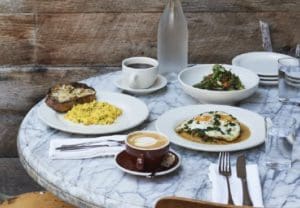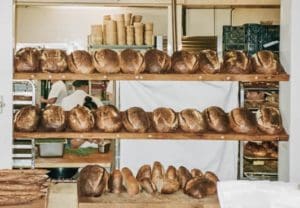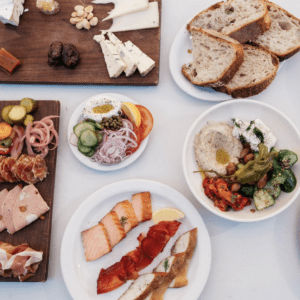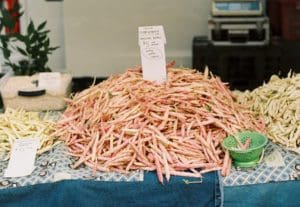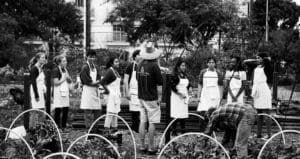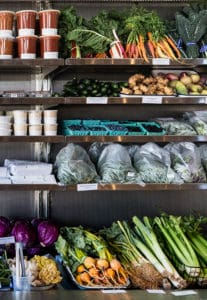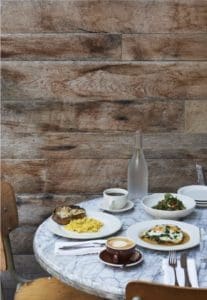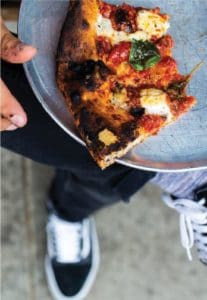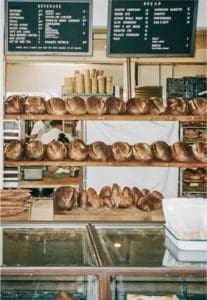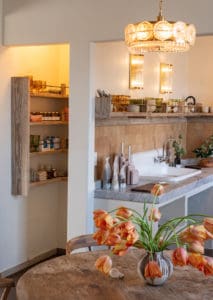
A Trip to the Market with Max
A morning visit to the Wednesday Santa Market with our produce buyer Max Dornbush — and a conversation about letting the seasons drive the menus across all the Gjelina Group restaurants.

Can you share a bit more about your background and what led you to Gjelina?
I was working as a line cook at another LA restaurant and a girlfriend took me on a date to Gjelina in March of 2013. I remember being mid-way through the meal and thinking, “I have got to learn how to make this food.” I kept talking about it and might have borderline ruined the date. So I showed up the following Monday at the back kitchen door. I started helping with the farmer’s market purchasing almost immediately for Gjelina and GTA. in the weeks before Gjusta opened, I realized there would be a need for a full-time purchaser so I asked if I could take on the role. Now it’s evolved into so much more.
What does your role as a liaison between chefs and food producers look like in practice?
Many, if not most, chefs work from ideas and techniques, to ingredients that fit their imagination, to the finished dish. In this group the individual dishes and the overall menus are driven by the seasons and changing availability. It’s a dialogue between our producers and our chefs which I facilitate.
For example, this month Chef Juan at Valle might say to me, “I need a new soup for the fall.” And I’ll tell him Coleman Farm is harvesting sunchokes next week, Finley Farm is starting celery root, and Thao’s Farm is harvesting leeks. And he’ll tell me which intrigues him and maybe ask me to find something else if it’s available – like chervil, perhaps. We’ll get in the ingredients, and go from there.
Can you speak to trust and how this gets developed in the context of farm-to-restaurant relationships?
The most valuable thing I do is build relationships. We usually have one or two, rarely three, suppliers for items. Often people grow or make things just for us. And the loyalty is measured in years, over a decade for Gjelina.
Also, there’s a lot of communication, mostly through text messages. Conversations with the chefs in the evenings as they’re closing, conversations with farmers in the mornings as they’re going to work, distributors and everyone else mid day as trucks are packed and orders go out.

What excites you most about your work?
It’s the constant learning that’s exciting to me. And, to be specific, working with (and tasting) two of the most highly perishable items — the fruit and the seafood. Tasting some of California’s best (maybe some of the world’s best) stone fruit, figs, and melons in the summers is a treat.
Which farms are most inspiring or interesting to you?
We have some people who are “our farmers” for certain items. For example, the Woolley family at Peads & Barnetts farm raises pigs and grows flowers and grapefruits. Or Schaner Farms of Valley Center for our citrus juice. They’re truly a family farm – when you see them at the market, there might be four members of the Schaner family working together there at once. At Munak Ranch of Paso Robles, three generations of the Gomez family live on the farm and provide us with incredible produce. They’re also some of the most kind and hardworking people i’ve had the pleasure of calling my friends.
Which radical or obscure crops have changed the way you understood your work or food growing in general?
So many! To take fruits, for example, from Tashkent nectarines that (variety originated in Uzbekistan) to European medlars to heritage varieties of apples from 1600’s France and England, California grows it all.
What’s changed my perspective is not any individual item, but the variety of microclimates and conditions in California that allow for so many different things to grow. Where else in the world can you grow date palms (Mecca, CA is named after Mecca, Saudi Arabia for good reason!), drive two hours to see berries growing by the Pacific Ocean, and then another two hours drive and you’re at a high elevation where there’s apples and pear trees? Where else?!
We’ve made progress in our broader conception of the complexity of our food chains and systems, but we still have a long way to go. What helps you stay connected to your own consumption?
What keeps me grounded is going to the market every week. And that’s the simplest thing anyone can do to make a difference in the food system. You vote and contribute with your dollar – where you choose to spend it. Go buy something directly from the person who created it, then come back again the next week. It requires a change in routine, and not everyone has access (a different issue also worth discussing), but if you can, it makes a difference that’s worth the effort.

What have you been learning since the opening of Valle?
I’ve been able to delve into a old world that’s new to me. Landrace corn, mezcal production, cheeses, Mexican fruits… every time we do something, it creates a learning opportunity. For someone who loves food and is building a career around it, the learning is invaluable.
Subscribe To Our Newsletter
Receive updates on new menu items, recipes, stories, and updates from the Gjelina Group.
